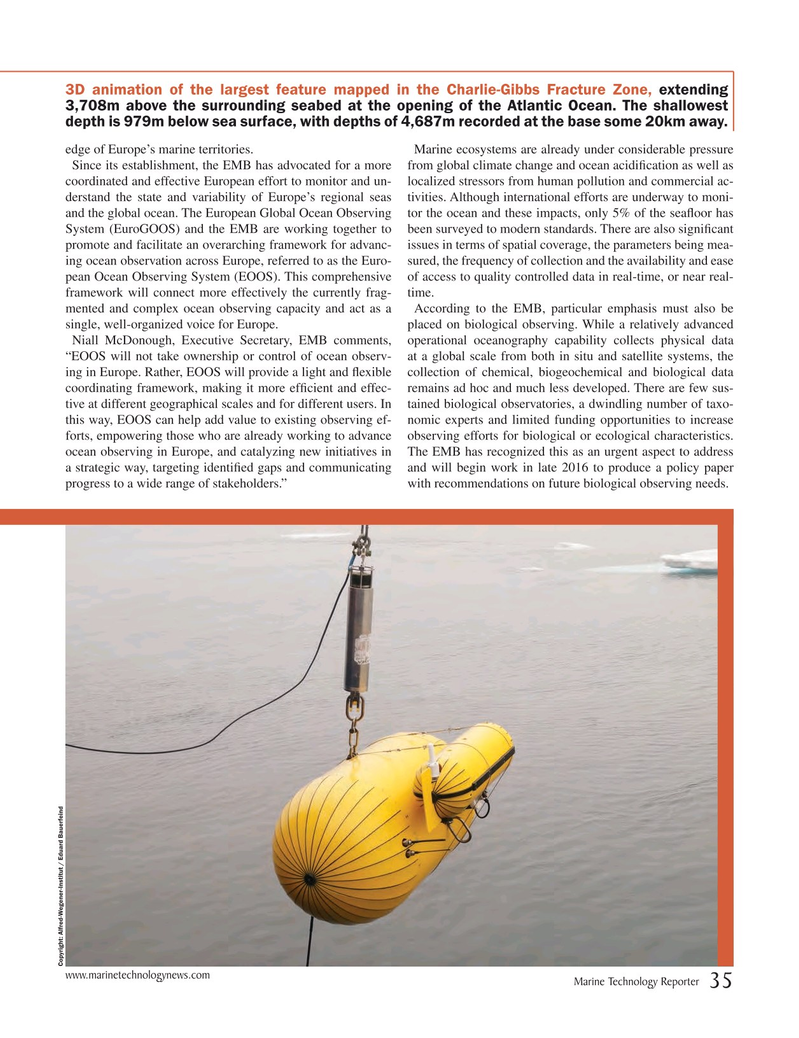
Page 35: of Marine Technology Magazine (September 2016)
Ocean Observation: Gliders, Buoys & Sub-Surface Networks
Read this page in Pdf, Flash or Html5 edition of September 2016 Marine Technology Magazine
3D animation of the largest feature mapped in the Charlie-Gibbs Fracture Zone, extending 3,708m above the surrounding seabed at the opening of the Atlantic Ocean. The shallowest depth is 979m below sea surface, with depths of 4,687m recorded at the base some 20km away. edge of Europe’s marine territories. Marine ecosystems are already under considerable pressure
Since its establishment, the EMB has advocated for a more from global climate change and ocean acidi? cation as well as coordinated and effective European effort to monitor and un- localized stressors from human pollution and commercial ac- derstand the state and variability of Europe’s regional seas tivities. Although international efforts are underway to moni- and the global ocean. The European Global Ocean Observing tor the ocean and these impacts, only 5% of the sea? oor has
System (EuroGOOS) and the EMB are working together to been surveyed to modern standards. There are also signi? cant promote and facilitate an overarching framework for advanc- issues in terms of spatial coverage, the parameters being mea- ing ocean observation across Europe, referred to as the Euro- sured, the frequency of collection and the availability and ease pean Ocean Observing System (EOOS). This comprehensive of access to quality controlled data in real-time, or near real- framework will connect more effectively the currently frag- time. mented and complex ocean observing capacity and act as a According to the EMB, particular emphasis must also be single, well-organized voice for Europe. placed on biological observing. While a relatively advanced
Niall McDonough, Executive Secretary, EMB comments, operational oceanography capability collects physical data “EOOS will not take ownership or control of ocean observ- at a global scale from both in situ and satellite systems, the ing in Europe. Rather, EOOS will provide a light and ? exible collection of chemical, biogeochemical and biological data coordinating framework, making it more ef? cient and effec- remains ad hoc and much less developed. There are few sus- tive at different geographical scales and for different users. In tained biological observatories, a dwindling number of taxo- this way, EOOS can help add value to existing observing ef- nomic experts and limited funding opportunities to increase forts, empowering those who are already working to advance observing efforts for biological or ecological characteristics. ocean observing in Europe, and catalyzing new initiatives in The EMB has recognized this as an urgent aspect to address a strategic way, targeting identi? ed gaps and communicating and will begin work in late 2016 to produce a policy paper progress to a wide range of stakeholders.” with recommendations on future biological observing needs.
Copyright: Alfred-Wegener-Institut / Eduard Bauerfeind www.marinetechnologynews.com
Marine Technology Reporter 35
MTR #7 (34-49).indd 35 8/25/2016 2:28:26 PM

 34
34

 36
36
